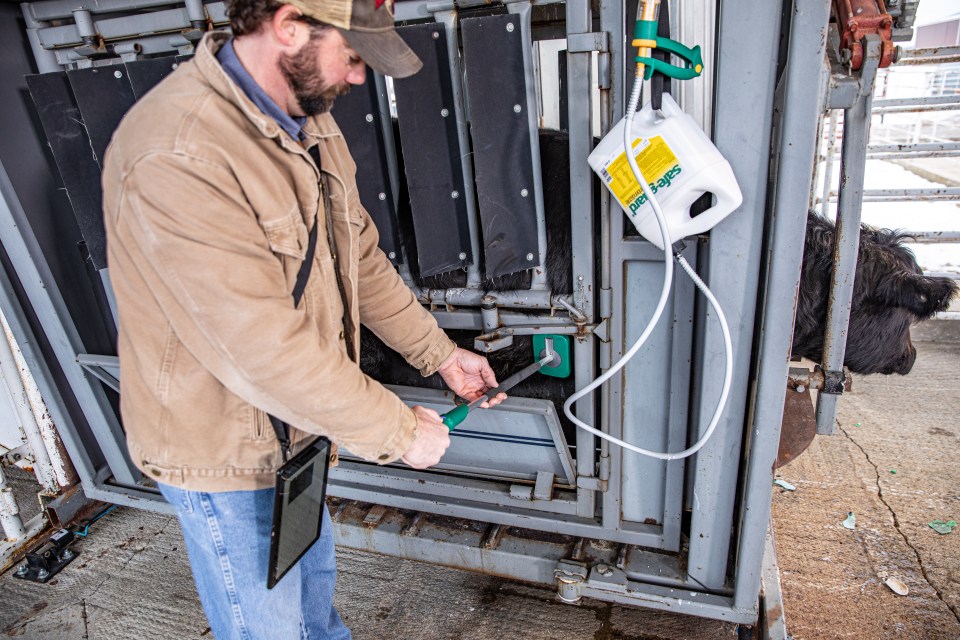Advancing cattle health through real-time, actionable data
By Dr. Jason Nickell
How do we advance cattle health as an industry? How about in your herd or feedlot?
We can significantly impact the future of animal health through new technologies, allowing cattle producers access to real-time, actionable data that can improve animal management, health outcomes, and ultimately your bottom line.
Using data to predict and manage BRD
Bovine respiratory disease (BRD) complex involves the pathogen (virus or bacteria), the calf (the host), and the environment and stressors, which all work in tandem to cause disease manifestation. BRD is the number one health issue we deal with on a day-to-day basis in post-weaned animals.

There are three categories of data and intelligence use as it relates to BRD – disease prediction, detection and confirmation.
The ability to predict BRD at the group or lot level using perceived risk factors is a highly inaccurate exercise. Until recently, the only tool to select animals needing an antibiotic was a thermometer. Producers could take the temperature of each calf and only give antibiotics to animals who have a certain elevated rectal temperature. However, research shows fever-based treatment is less effective than conventional metaphylactic group treatment for decreasing the prevalence of BRD in newly arrived cattle. The data indicates rectal temperature alone is not predictive of BRD incidence.
Metaphylaxis, a tried-and-true BRD management practice, has historically focused on administering antibiotics to each animal in the group. WHISPER® ON ARRIVAL is the first technology of its kind with the goal of optimizing metaphylaxis use.
The objective is to predict which animals need antimicrobial therapy and which do not. This will reduce the cost of treatment and support judicious antimicrobial use all while maintaining the positive attributes of conventional BRD control.
The technology’s predictive algorithm uses up to four data points – the animal’s lung sound, heart sound, rectal temperature and weight. Heart and lung sounds are captured with a hardware device, while rectal temperature and body weight are currently hand entered into the application. Based on individual animal examination, the algorithm calculates each animal’s risk of developing BRD and provides a simple “treat” or “do not treat” outcome. The technology identifies which cattle are likely to respond to antimicrobial therapy for BRD control while leaving the remaining population untreated
Development studies across four sites demonstrated that pens managed with the technology displayed no statistical differences in health and performance compared to the positive control. Pens managed by this technology reduced metaphylactic antibiotic use by 10-43 percent compared to conventional metaphylaxis.
Detecting BRD via technology
Cattle’s defense mechanism is to appear healthy, even when sick. That is why a sick animal will often look alert and conceal signs of sickness if it knows it is being watched.
The SenseHub® Feedlot technology is used to monitor activity and body temperature to detect sick animals earlier and more accurately. Body temperature is captured by an infrared thermistor that captures ear temperature. A built-in accelerometer measures activity. The hardware is very minimal. It consists of the ear tag, an antenna placed strategically on site and a gateway where the data is collected, stored and sent to a data platform.
The user receives a report of animals flagged by the system. The tag is assigned to the animal’s visual ID number and lot/pen. In parallel, there is a light on the tag that illuminates so pen riders can easily identify animals with blinking lights on their tag. This allows them to find and remove sick animals with minimal disruption.
Confirming BRD at the chute
The WHISPER® HOSPITAL technology aids in the diagnosis of BRD by estimating the degree of lung pathology at the time when cattle are brought to the chute for assessment. The user receives a severity score of 1-5 (lung pathology, and subsequently the risk of retreatment and mortality rising with an increase in severity). Using the score, producers can determine the severity of the disease and use those data to make treatment and/or management decisions.
Just as precision agriculture has been incorporated into row-crop agriculture, adding new technology can seem like a daunting task. It is important to start with your goals and determine what makes sense for your operation and to seek out those who can help you along the way.
Find more content for your beef operation.
About the author

Dr. Jason Nickell
D.V.M., Ph.D., DACVPM,
Director of Insights and Outcomes,
Merck Animal Health
